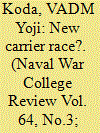|
|
|
Sort Order |
|
|
|
Items / Page
|
|
|
|
|
|
|
| Srl | Item |
| 1 |
ID:
111115


|
|
|
|
|
| Publication |
2011.
|
| Summary/Abstract |
On 16 December 1907 President Teddy Roosevelt launched the deployment
of sixteen brand-new, glistening white, steam-powered battleships on a
fourteen-month circumnavigation of the globe.
1
Later known as the "Great
White Fleet," the armada demonstrated America's new ability to project its
power abroad and represented a turning point in global power politics. The
cruise is still widely recognized as an important achievement for the U.S. Navy.
In the century since then, in which the United States has emerged as the world's
sole superpower, its navy has made some strides in transforming itself for the
purpose of dealing with new and emerging global threats. It continues to face
such challenges, and it remains to be seen how effective it will be with its ongoing transformation.
|
|
|
|
|
|
|
|
|
|
|
|
|
|
|
|
| 2 |
ID:
111114


|
|
|
|
|
| Publication |
2011.
|
| Summary/Abstract |
On 18 March 2009 JS Hyuga (DDH 181) was commissioned and delivered to
the Japan Maritime Self-Defense Force (JMSDF). The unique characteristic of this ship is its aircraft-carrier-like design, with a "through" flight deck and
an island on the starboard side.Hyuga was planned in the five-year Midterm Defense Buildup Plan (MTDBP) of 2001 and funded in Japanese fiscal year (JFY)
2004 as the replacement for the aging first-generation helicopter-carrying destroyer (DDH), JS Haruna (DDH 141), which was to reach the end of its service
life of thirty-five years in 2009. The second ship of the new class, JS Ise (DDH
182), of the JFY 2006 program, was commissioned 16 March 2011. A third DDH,
an improved sister of the Hyuga-class ships, was funded in the JFY 2010 budget.
The fourth and last DDH, most likely to be a second ship of the improved type, is
to be built in the next five-year program, from JFY 2011 to 2015 (see figure 1 and
sidebar).
|
|
|
|
|
|
|
|
|
|
|
|
|
|
|
|
| 3 |
ID:
111116


|
|
|
|
|
| Publication |
2011.
|
| Summary/Abstract |
The 1982 United Nations Law of the Sea Convention (UNCLOS) is, quite understandably, viewed by many as the "be all, end all" statement and source of
the law of the sea. Not only does the convention's name imply that it occupies the
field, so to speak, but its sheer size, scope, ubiquity, and near-universal acceptance support such a perception. Even the United States, which has not ratified
UNCLOS, considers most of its provisions to reflect, or to have achieved the status of, customary international law and thus to be binding on nations that do
not specifically decline to adhere to them.
|
|
|
|
|
|
|
|
|
|
|
|
|
|
|
|
| 4 |
ID:
111113


|
|
|
|
|
| Publication |
2011.
|
| Summary/Abstract |
Aircraft carriers symbolize a country's overall strength. They are also the
core of the navy's combined-arms sea operations. Building carriers has all
along been a matter of concern for the Chinese people. To modernize our
national defense and build a perfect weaponry and equipment system, we
have to consider the development of carriers
|
|
|
|
|
|
|
|
|
|
|
|
|
|
|
|
| 5 |
ID:
111117


|
|
|
|
|
| Publication |
2011.
|
| Summary/Abstract |
In the early 1950s the U.S. Navy and Marine Corps were suffering near-catastrophic
accident rates. In 1954 alone the Navy/Marine Corps accident rate was almost
fifty-five major mishaps per hundred thousand flight hours, meaning that 776
aircraft and 535 aviators were lost. This was unsustainable. Two British inventions, the angled flight deck and the optical landing system, ameliorated the
problems of flying jet aircraft at sea, but widespread safety problems persisted,
not only in carrier operations but in shore-based operations as well. It was apparent that beyond carrier modifications and other technological fixes, there
were institutional changes that needed to be made. This article chronicles several of these changes at a critical period in the service's history.
|
|
|
|
|
|
|
|
|
|
|
|
|
|
|
|
| 6 |
ID:
111118


|
|
|
|
|
| Publication |
2011.
|
| Summary/Abstract |
Wargaming has a long history as an important tool for military training,
education, and research.
1
In its broader application to nonmilitary conflict situations (see, for example, the recent books Wargaming for Leaders and
Business War Games), the technique is increasing in popularity, particularly
among businesses seeking strategic advantages.
2
(As a result, we will sometimes
use the terms "wargaming" and "gaming" interchangeably; in the latter case,
however, we mean what is called "serious gaming," not the more general sense,
like gambling.)
3
Despite that history and popularity, however, wargaming's record of success is uneven. Some games seem to succeed very well in preparing important decision makers for real-world environments
in which they later find themselves.
|
|
|
|
|
|
|
|
|
|
|
|
|
|
|
|
|
|
|
|
|